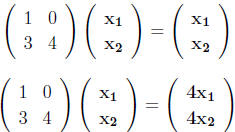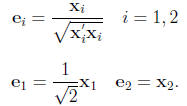MATRIX ALGEBRA
Example:

From the first expression,

From the second expression

Usual practise to determine an eigenvector with length one. In the example:

Definition: Quadratic form Q(x) in k variables
![]() , where
, where
 ,
,
is defined as
Q(x) = x'Ax where A is a fix (k × k) matrix
The quadratic form is a quadratic function of
![]() .
.
Example:

Theorem Let A be a (k × k) symmetric matrix, (i. e. A =
A') then A has k pairs of
eigenvalues and eigenvectors

The eigenvectors can be chosen to satisfy

and be mutually perpendicular. The eigenvectors are unique
unless two or more eigenvalues
are equal.
Definition: Positive Definite Matrices Let A be a symmetric matrix (k × k). A is
said to be positive definite if
x'Ax > 0 for all x ∈ Rk x ≠ 0.
A is positive semi-definite if
x'Ax ≥ 0 for all x ∈ Rk.
Theorem: Spectral decomposition of a symmetric (k × k) matrix A is given:

 are eigenvalues of A
and
are eigenvalues of A
and  are
the associated normalized eigenvectors.
are
the associated normalized eigenvectors.
Theorem A, (k × k) symmetric matrix is positive definite if and only if every eigenvalue
of A is positive.
A is positive semi-definite if and only if every eigenvalue of A is nonnegative.
Proof: Trivial from the spectral decomposition theorem.

where  . Choosing x =
. Choosing x =
 , j = 1, . . . , k) follows
the theorem.
, j = 1, . . . , k) follows
the theorem.
Another form of the spectral decomposition:

INVERZE AND SQUARE ROOT OF A POSITIVE DEFINIT MATRIX
By the spectral decomposition, if A is positive definite:

Inverse of A If A is positive definite, then the eigenvaluse of A are

 i = 1, . . . , k. The inverse of A is
i = 1, . . . , k. The inverse of A is
 where
where
 .
.
Because;

Square Root Matrix (defined for positive semi-definite A)

Notice:

MATRIX INEQUALITIES AND MAXIMIZATION
Cauchy-Schwarz Inequality: Let b, d ∈ Rp, then

with equality if and only if b = cd.
Proof: The inequality is obvious when one of the vectors is the zero one. For b
− xd ≠ 0 we
have that,

Adding and substratcting
 , we have that
, we have that

Choosing x = b'd/d'd follows the statement.
Extended Cauchy–Schwartz Inequality: Let b, d ∈ Rp and let B be a positive
definite
(p × p) matrix. Then

with equality if and only if b = cB-1d for some constant c.
Maximization of Quadratic forms on the Unit Sphere:
Let B be a (p × p) positive definite matrix with eigenvectors
 and
associated
and
associated
eigenvalues  eigenvectors, where
eigenvectors, where
 . Then
. Then

Moreover

and the equality is attained when
 .
.




